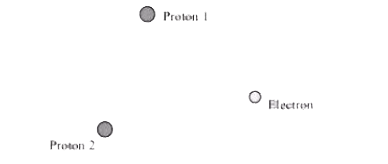If one of the two electrons of a hydrogen molecule is removed, we get a hydrogen molecule ion (H+2). In the ground state of H+2, the two protons are separated roughly by 1.5Å and electron is roughly 1Å from each proton. Determine the potential energy of the system. Specify your choice of zero of potential energy.
The system of two protons and one electron is represented in the given figure.

Charge on proton 1, q1=1.6×10−19C
Charge on proton 2, q2=1.6×10−19C
Charge on electron , q3=−1.6×10−19C
Distance between protons 1 and 2 d1=1.5×10−10m
Distance between proton 1 and electron d2=1×10−10 m
Distance between proton 2 and electron , d3=1×10−10m
the potential energy at infinity is zero .
potential energy of the system
V=q1q24π∈0d1+q2q34π∈0d3+q3q14π∈0d2
Substituting 14π∈0=9×109Nm2C−2 , we obtain
V=9×109×10−19×10−1910−19[−(16)2+(1.6)21.5+(1.6)2]
=−30.7×10−19J
=−19.2eV
Therefore, the potential energy of the system is −19.2eV.
Topper's Solved these Questions
- BOOK - NCERTCHAPTER - ELECTROSTATIC POTENTIAL AND CAPACITANCEEXERCISE - Exercise37videos
ELECTROSTATIC POTENTIAL AND CAPACITANCE
- BOOK - NCERTCHAPTER - ELECTROMAGNETIC WAVESEXERCISE - Exercise15videos
ELECTROMAGNETIC WAVES
- BOOK - NCERTCHAPTER - MAGNETISM AND MATTEREXERCISE - Exercise25videos
MAGNETISM AND MATTER
Similar Questions
If one of the two electrons of a H2 molecule is removed, we get a hydrogen molecular ion (H+2). In the ground state of an (H+2), two protons are separated by roughly 1.5 Å and the electron is roughly 1 Å from each proton. Determine the potential energy of the system. Specify your choice of the zero of potential energy.
View SolutionIf one of the two electrons of a H2 molecule is removed, we get a hydrogen molecular ion H+2.In the ground state of an H+2, the two protons are separated by roughly 1.5 Å, and the electron is roughly 1 Å from each proton. Determine the potential energy of the system. Specify your choice of the zero of potential energy.
View Solution
Knowledge Check
- Question 1 - Select One
If electron in a hydrogen atom has moves from n = 1 to n = 10 orbit, the potential energy of the system has
AincreasedBdecreasedCremained unchangedDbecome zero - Question 2 - Select One
If the electron in a hydrogen atom moves from ground state orbit to 5th orbit, then the potential energy of the system
ABecome zeroBIs decreasedCIn increasedDRemained unchanged - Question 3 - Select One
The angular momentum of an electron in the hydrogen atom is 2hπ. What is the potential energy of this electron ?
A−0.85eVB−1.51eVC−1.70eVD−4.3eV
Two protons are brought towards each other. Will the potential energy of the system decrease or increase? If a proton and an electron be brought nearer, then?
View SolutionShow that the energy of hydrogen atom in the ground state is
E=−18πε0e2r
[Hint: Energy in the gound state = kinetic energy of electron in the first orbit + electrostatic potential energy of the electron.]View SolutionIn the ground state of the hydrogen atom, the electron has a total energy of -13.6 eV. What are (a) its kinetic energy and (b) its potential energy if the electron is one Bohr radius from the central nucleus?
View SolutionHow much energy is required to cause an electron of hydrogen to move from n = 1 state to n = 2 state?
View SolutionThe electron in a hydrogen atom at rest makes a transition from n=2 energy state to the n=1 ground state.
find the energy (eV) of the emitted photon.View Solution

